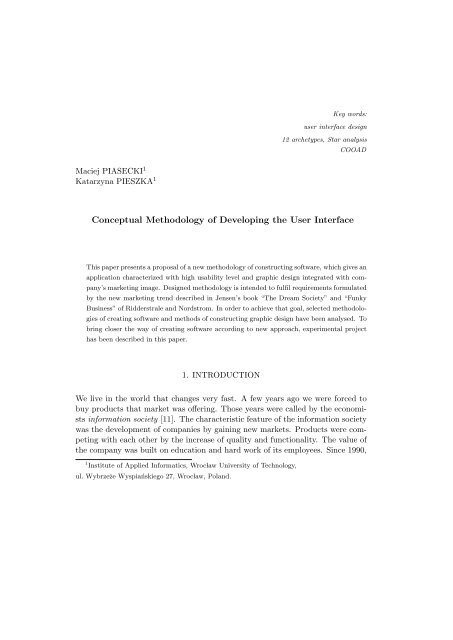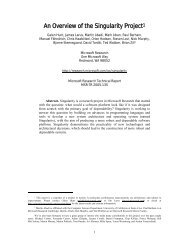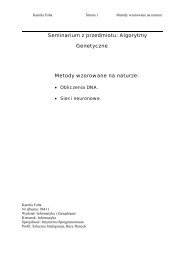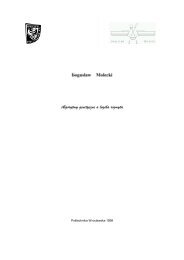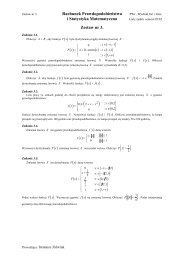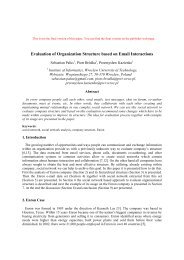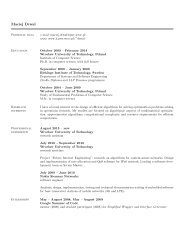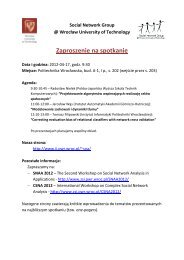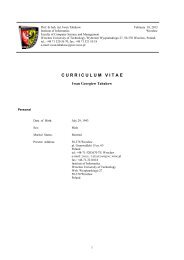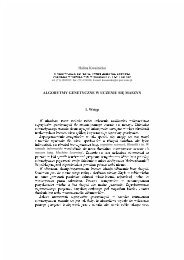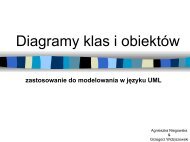Conceptual Methodology of Developing the User Interface
Conceptual Methodology of Developing the User Interface
Conceptual Methodology of Developing the User Interface
You also want an ePaper? Increase the reach of your titles
YUMPU automatically turns print PDFs into web optimized ePapers that Google loves.
En conclusión, la evidencia científica no ha demostrado que lahomosexualidad sea el resultado directo de causas biológicas, genéticas oneuro hormonal. Lo más que se puede decir es que pudiera existir alguna basegenética, hormonal, neurológica o cerebral que predispone a lahomosexualidad. Esta pudiera inclinar a unas personas más que a otras alhomosexualismo, pero no obligarlas a practicarlo.ACTITUDOrganización relativamente estables de creencias , sentimientos ytendencias de conducta dirigidas hacia algo o alguien, el objeto de la actitud.Cambios recientes en la actitud de la sociedad hacia la homosexualidadhan ayudado a algunos/algunas adolescentes homosexuales a sentirse máscómodos con su orientación sexual.ESTUDIANTES DE PREPARATORIA / ADOLESCENCIAPara todo adolescente el desarrollo es una tarea llena de retos ydemandas. Un aspecto importante consiste en definir su identidad sexual.Todos los niños exploran y experimentan sexualmente como parte de sudesarrollo normal. Este comportamiento sexual puede llevarse a cabo conmiembros del mismo sexo o del sexo opuesto. A muchos adolecentes el pensaren o experimentar con personas del mismo sexo puede causarlespreocupación y ansiedad con respecto a su orientación sexual.A otros, aún los pensamientos o fantasías pueden causarles ansiedad.CONCLUSIONES:- Como inicio tenemos que nuestros dos grupos principales que son lasescuelas, al aplicarles la prueba KS-1 se dio a notar que tenemos datosnormales los cuales nos dan el parámetro inicial para poder medirlos con la Tde student para grupos independientes.- Una vez aplicadas las pruebas de normalidad de datos, procedimos a utilizarla prueba T de Student para grupos independientes donde comparamos anuestros dos grupos (escuelas) y el resultado que nos arrojó fue primeramenteuna significancia de .131 por lo que se asumen varianzas iguales. Lasignificancia mostrada en la prueba T fue de .077 por lo que se deduce que nose obtuvo una diferencia significativa entre estos dos grupos, al menos dentrode un nivel alfa de 0.05- También se realizó la prueba de K-S para las preguntas 1 4 6 12 16 y 22 paracomprobar, de igual manera, su normalidad. Después de comprobar que losdatos son normales se procedió a aplicar la prueba T de Student para estaspruebas en específico, ya que para nosotros esas fueron as preguntas son lasmas significativas.- En la pregunta 1, la cual dice que tanto te incomoda hablar sobre lahomosexualidad obtuvimos como resultado que el 64.6% de nuestra poblaciónrespondió totalmente desacuerdo y solo el 6.1% contesto que esta totalmente
<strong>the</strong> design <strong>of</strong> <strong>the</strong> core <strong>of</strong> <strong>the</strong> system and defines also <strong>the</strong> meaning <strong>of</strong> UI elements.The integration <strong>of</strong> COOAD with USDP is presented in [5].2.3. STAR ANALYSISThe star analysis is a method <strong>of</strong> creating a graphic design, which is based on <strong>the</strong>six orientation points. The description <strong>of</strong> all those points gives a context whichsurrounds <strong>the</strong> multimedia production (Fig. 1).“The six orientation points are: intention, aim, resources, tradition,situation and motive for <strong>the</strong> two participants in <strong>the</strong> visual communicationsituation. They are closely connected to each o<strong>the</strong>r and influenceeach o<strong>the</strong>r. They should be seen more as signposts in <strong>the</strong> landscapethan as boxes with individual and independent meaning. The intentionis that careful consideration <strong>of</strong> <strong>the</strong>se six points will make it easierto find solutions to being a successful ‘communication organiser’ —and to find out what can have been <strong>the</strong> reason for a particular type<strong>of</strong> communication to have been arranged as it is.The star analysis is also intended as both being forward looking descriptivein relationship to creation <strong>of</strong> an interactive communication,and backward looking analytical in relationship to an already existinginteractive communication. [1]”Figure 1: Star analysis
Agerbæk points out what kind <strong>of</strong> information should be present in <strong>the</strong> description<strong>of</strong> six orientation points. Each description is divided into two parts. The firstone is a description from host’s and <strong>the</strong> o<strong>the</strong>r one is from guest’s point <strong>of</strong> view[1]:• Tradition:<strong>the</strong> host — “It is important to know <strong>the</strong> host’s tradition in forming messagesso that <strong>the</strong> new message will be in keeping to such a degree that <strong>the</strong>design can be recognised as coming from a definite host. It is relevant hereto be able to follow a line <strong>of</strong> design or a less organised visual identity andto be able to make <strong>the</strong> layout within <strong>the</strong> visual identity.”;<strong>the</strong> guest — “The important thing is to be aware <strong>of</strong> which visual expectations<strong>the</strong> guests have. The visual expectations <strong>of</strong>ten relate to how <strong>the</strong>branch generally presents itself. One should pay close attention to fieldsbeyond <strong>the</strong> digital media.”.• Situation:<strong>the</strong> host — “A piece <strong>of</strong> visual design always has a situation. That means aspecific point in space and time where <strong>the</strong> conversation between host and<strong>the</strong> guests actually happens.”;<strong>the</strong> guest — ”[...] relevant to look at what physical situations <strong>the</strong> guestsare in when <strong>the</strong>y actually click into <strong>the</strong> site”.• Motive: this point is not divided, because both for guest and host, it isvery important to have knowledge about <strong>the</strong> newest visual solutions forpresenting data and interactive tools for guest and host.• Aim: <strong>the</strong> aim is <strong>the</strong> concrete results which both host and <strong>the</strong> guests expectby taking part in <strong>the</strong> communication on <strong>the</strong> site;<strong>the</strong> host — “The host may have a specific aim for starting <strong>the</strong> dialogue - itmay be that he wants to write a book toge<strong>the</strong>r with <strong>the</strong> users <strong>of</strong> <strong>the</strong> site.”;<strong>the</strong> guest — “The aim <strong>of</strong> <strong>the</strong> guest in looking up <strong>the</strong> web site can be verydifferent from <strong>the</strong> host’s. It can be to find a new identity via <strong>the</strong> productsthat can be bought on <strong>the</strong> site.”.• Resources:<strong>the</strong> host — “It is <strong>of</strong> great importance how many resources <strong>the</strong> host investsin <strong>the</strong> project in <strong>the</strong> form <strong>of</strong> money or time.”;
<strong>the</strong> guest — “Guests have in advance a number <strong>of</strong> resources. They can beeconomic - it is a fact that an on-line shop owner needs to be aware <strong>of</strong> hiscustomers’ economic situation, but it can also be knowledge.”.• Intension:<strong>the</strong> host — “An interactive multimedia production starts with an invitation.Behind this is a host who wants to start a dialogue. With this he has anintention.”;<strong>the</strong> guest — “It is also crucial for <strong>the</strong> designer to consider <strong>the</strong> intention <strong>of</strong>those invited. He or she also takes part in <strong>the</strong> communication and must<strong>the</strong>refore have a reason to come.”.2.4. 12 ARCHETYPES”The archetype-concept is deeply rooted in Carl Gustav Jung’s <strong>the</strong>ories.Jung defines an archetype as: <strong>the</strong> manifestation <strong>of</strong> sense perceivedinstincts in <strong>the</strong> form <strong>of</strong> fantasies or symbolic images. [...] Anarchetype is in o<strong>the</strong>r words a human type, performing in its purestform. [6]”Brand House company [4] took <strong>the</strong> concept <strong>of</strong> archetype as <strong>the</strong> basis for presenting<strong>the</strong> relationship between customer and user. The main task <strong>of</strong> Brand House wasto create brand’s marketing image. After <strong>the</strong> year 1998 <strong>the</strong>y started to buildbrand identity, in which information about company’s goal, mission, productsand employees are indicating a direction <strong>of</strong> fur<strong>the</strong>r development, managing andcommunication inside <strong>the</strong> company. One <strong>of</strong> <strong>the</strong> tools <strong>of</strong> building brand identity is<strong>the</strong> method <strong>of</strong> 12 archetypes. The uniqueness <strong>of</strong> 12 archetypes method is that ittransfers universal and recognized, human values into marketing strategy <strong>of</strong> <strong>the</strong>company.”Archetypes function as models that can provide answers to manydilemmas and considerations related to management and communication.[6]”Brand House identified 12 archetypes and described <strong>the</strong>m in terms <strong>of</strong> <strong>the</strong>ir wishes,dreams, talents, fears, etc. Method <strong>of</strong> 12 archetypes is based on matching <strong>the</strong>company to archetype and creating a visual design by analysing <strong>the</strong> archetype.
3. THE IDEA FOR METHODOLOGYThe proposed methodology called IDI (Integrated Design <strong>of</strong> <strong>Interface</strong>) (Fig. 2).incorporates <strong>the</strong> approach <strong>of</strong> presenting a customer and <strong>the</strong> use <strong>the</strong> essential elements<strong>of</strong> methods <strong>of</strong> constructing graphic design (12 archetype, Star analysis)[7, 11]. Usability s<strong>of</strong>tware is built on <strong>the</strong> basis <strong>of</strong> COOAD. High quality application’simplementation is constructed by applying <strong>of</strong> <strong>the</strong> eXtreme Programming(XP) method [3].Figure 2: <strong>Methodology</strong> IDI3.1. MAIN GUIDELINESIDI divides <strong>the</strong> process <strong>of</strong> creating s<strong>of</strong>tware into six stages. Information ga<strong>the</strong>redin some earlier stage is necessary to continue <strong>the</strong> process in <strong>the</strong> next stage.Names <strong>of</strong> <strong>the</strong> stages and goals come mostly from COOAD. Each stage includesimportant parts <strong>of</strong> XP methodology and elements <strong>of</strong> 12 archetypes and <strong>the</strong> staranalysis methods.Elements taken from COOAD’s methodology [8]: customer and user description,identification <strong>of</strong> users classes, identification <strong>of</strong> vocabulary used in customer’s environment,discovery <strong>of</strong> metaphors, construction <strong>of</strong> desirable UMM, description <strong>of</strong><strong>the</strong> technological environment, and paper prototype <strong>of</strong> UI.XP is <strong>the</strong> basis for <strong>the</strong> implementation. The elements <strong>of</strong> XP play a significantrole in specifying demands and constructing s<strong>of</strong>tware: construction <strong>of</strong> user stories,description <strong>of</strong> system metaphor, making decisions about technology and defining
<strong>the</strong> abilities, <strong>the</strong> architectural project and design patterns, making decision aboutnaming convention, fulfilling <strong>the</strong> plan, <strong>the</strong> realisation <strong>of</strong> <strong>the</strong> system.Each stage <strong>of</strong> IDI includes elements <strong>of</strong> 12 archetypes and star analysis method:<strong>the</strong> goal <strong>of</strong> creating <strong>the</strong> application, visual traditions <strong>of</strong> <strong>the</strong> customer, visualexpectations <strong>of</strong> <strong>the</strong> user, <strong>the</strong> latest visual solutions, a paper prototype <strong>of</strong> UI, <strong>the</strong>design <strong>of</strong> user interface constructed in a graphical program.The description <strong>of</strong> an IDI stage includes all <strong>the</strong> necessary information to understand<strong>the</strong> purpose <strong>of</strong> this stage. Every stage has a piece <strong>of</strong> advice and <strong>the</strong> decisionmust be made whe<strong>the</strong>r it is relevant to <strong>the</strong> project. IDI does not impose any documentationformat, it is only important that documentation <strong>of</strong> <strong>the</strong> project iseasily understood by a customer and project team.3.2. DESCRIPTION OF STAGESFigure 3: Stages <strong>of</strong> methodology IDIIDI methodology consists <strong>of</strong> <strong>the</strong> six subsequent stages (Fig. 3):1. Description <strong>of</strong> usage context — this stage consists <strong>of</strong> all information whichdescribe: users — description <strong>of</strong> <strong>the</strong> users, <strong>the</strong>ir habits, tasks performed
y <strong>the</strong>m and physical limitations; customer — organisational structure, hisgoals and motto; goals, which building system has to fulfil. The informationga<strong>the</strong>red in description <strong>of</strong> usage context stage is a starting point for fur<strong>the</strong>rstages <strong>of</strong> building application.2. Analysis <strong>of</strong> usage context — <strong>the</strong> result <strong>of</strong> this stage is a set <strong>of</strong> functionality<strong>of</strong> application that is being build, dictionary and metaphors, which can beused in target user interface.3. <strong>Conceptual</strong> project — it is <strong>the</strong> most important part <strong>of</strong> IDI, because it is <strong>the</strong>point in which <strong>the</strong> transformation from collecting information to technicallevel <strong>of</strong> building system is being made. The source <strong>of</strong> information neededfor that stage are documents created during <strong>the</strong> work over <strong>the</strong> analysis <strong>of</strong><strong>the</strong> usage context stage. <strong>User</strong>’s stories are <strong>the</strong> functionality <strong>of</strong> buildingsystem, dictionary is a base <strong>of</strong> naming objects and activities performed by<strong>the</strong> user in <strong>the</strong> application and classes <strong>of</strong> users reflects roles in <strong>the</strong> system.4. Graphical system project — getting known customer goals, mission, products,strategies and user’s tasks that have to be assisted by <strong>the</strong> buildingapplication, <strong>the</strong>re is <strong>the</strong> right time to design UI. This stage includes informationabout how to start <strong>the</strong> work and what documents are needed, aswell as practical hints and methods <strong>of</strong> designing interface.5. Technological analysis — <strong>the</strong> goal <strong>of</strong> this stage is to get to know <strong>the</strong> technicalparameters in which application will be working, making <strong>the</strong> decision abouttechnology in which application will be built, system’s architecture anddesign patterns. In this stage, <strong>the</strong> naming convention is chosen, which willbe followed by every programmes during <strong>the</strong> implementation.6. Creating s<strong>of</strong>tware — <strong>the</strong> s<strong>of</strong>tware is being built. The sub-stages <strong>of</strong> planningand developing application can be repeated many times, because <strong>the</strong>y arein <strong>the</strong> beginning <strong>of</strong> each iteration. The number <strong>of</strong> iterations depends <strong>of</strong>customer’s decision and <strong>the</strong> number <strong>of</strong> functionalities to be implemented.4. EXPERIMENT
The purpose <strong>of</strong> <strong>the</strong> experiment was to carry out a project and build an applicationaccording to stages <strong>of</strong> IDI and verify <strong>the</strong> results. As a result, IDI should gives<strong>of</strong>tware with interface integrated with marketing image <strong>of</strong> <strong>the</strong> customer and UIcharacterised by high usability level.Three students <strong>of</strong> <strong>the</strong> Faculty <strong>of</strong> Computer Science and Management <strong>of</strong> WroclawUniversity <strong>of</strong> Technology took part in <strong>the</strong> experiment. The subject <strong>of</strong> experimentalproject was to build an application that will help students to sign in toobligatory and optional courses. The students created thirteen user’s stories andseven <strong>of</strong> <strong>the</strong>m were implemented in two iterations. At <strong>the</strong> end <strong>of</strong> each iteration,usability tests were performed. The tests included a list <strong>of</strong> tasks to perform anda questionnaire to fill in. The questionnaire had eight questions about visualaspect <strong>of</strong> <strong>the</strong> created UI. After two iterations, <strong>the</strong> summary test was applied inorder to evaluate <strong>the</strong> tasks, which were identified as <strong>of</strong>ten performed.The results <strong>of</strong> all tests were <strong>the</strong> basis <strong>of</strong> tentative evaluation <strong>of</strong> IDI methodology.The evaluation <strong>of</strong> <strong>the</strong> visual aspect <strong>of</strong> <strong>the</strong> interface was always between 6 and 7,in seven-point scale (1 means disappointment and 7 — full satisfaction <strong>of</strong> performinga task). 80% <strong>of</strong> all tasks included in <strong>the</strong> test were evaluated by <strong>the</strong> users as“very easy to do” and <strong>the</strong>re was no value lower <strong>the</strong>n “nei<strong>the</strong>r easy nor difficult”.It is very important that marks given in <strong>the</strong> second iteration were higher than<strong>the</strong> marks given by <strong>the</strong> users in <strong>the</strong> first one.Despite <strong>the</strong> very high evaluation <strong>of</strong> <strong>the</strong> experimental project, a tentative evaluation<strong>of</strong> methodology IDI cannot be done. The reasons for this are: <strong>the</strong> projectwas carried out by one person, <strong>the</strong> application was build by <strong>the</strong> creator <strong>of</strong> methodologyIDI, <strong>the</strong> subject <strong>of</strong> <strong>the</strong> experimental project was well known by <strong>the</strong>creator, and not all user’s stories were implemented. The evaluation <strong>of</strong> <strong>the</strong> methodologycannot by done after only one realised project. One needs to createmany applications and analyse <strong>the</strong> results, in order to be able to evaluate <strong>the</strong>methodology.5. CONCLUSIONThe goal <strong>of</strong> <strong>the</strong> work was to propose a methodology, which would fulfil <strong>the</strong> requirements<strong>of</strong> marketing trend [11, 7] and give s<strong>of</strong>tware with high usability <strong>of</strong> UI.Requirements formulated by Ridderstrale and Nordstrom impose <strong>the</strong> creation <strong>of</strong>marketing image <strong>of</strong> <strong>the</strong> company, employees and products as a whole. The way
to distinguish one company from many similar to it is to compete referring t<strong>of</strong>eelings and emotions. The company should tell a story and work, employ andfire people in <strong>the</strong> rhythm <strong>of</strong> <strong>the</strong> story. This trend requires from methodology <strong>of</strong>creating s<strong>of</strong>tware to build application integrated with <strong>the</strong> company’s image.Existing solutions <strong>of</strong> creating s<strong>of</strong>tware like USDP and COOAD have been usedgaining a lot <strong>of</strong> success for many years. USDP concentrates to build optimalarchitecture for <strong>the</strong> project. But <strong>the</strong> main disadvantage <strong>of</strong> USDP is a very rarecontact with <strong>the</strong> client; <strong>the</strong>y are limited to a few approval meetings. All changesin functionality are laborious, because <strong>the</strong> project needs to be redesigned andre-implementedCOOAD is a methodology that should give UI which provides <strong>the</strong> user with effective,satisfying and efficient way to perform tasks with <strong>the</strong> help <strong>of</strong> <strong>the</strong> application.The main disadvantage <strong>of</strong> COOAD is a lack <strong>of</strong> hints about how to create a graphicdesign <strong>of</strong> <strong>the</strong> user interface that will be integrated with marketing image <strong>of</strong><strong>the</strong> company. COOAD is also oriented on desktop applications. It is troublesomein <strong>the</strong> case <strong>of</strong> web pages.The reviewed methodologies do not fulfil requirements <strong>of</strong> marketing trend describedin [11] and [7], but <strong>the</strong>y are a starting point for a new one. The newapproach — IDI combines COOAD’s features with 12 archetypes and star analysiselements; methods <strong>of</strong> designing graphical interface, integrated with company’smarketing image. The practices and recommendations <strong>of</strong> XP lie in <strong>the</strong> base <strong>of</strong>project implementation.IDI is divided into six stages that include all necessary information to understand<strong>the</strong> purpose <strong>of</strong> each <strong>of</strong> <strong>the</strong>m. IDI puts emphasis on building s<strong>of</strong>tware, which ischaracterised with high usability level and graphic design integrated with company’smarketing image.For <strong>the</strong> tentative evaluation <strong>of</strong> <strong>the</strong> methodology, <strong>the</strong> experimental project wascarried out. The visual aspect <strong>of</strong> <strong>the</strong> application was evaluated very high in usabilitytests, performed in <strong>the</strong> end <strong>of</strong> each iteration. Despite <strong>of</strong> <strong>the</strong> high evaluation<strong>of</strong> <strong>the</strong> project in usability test <strong>the</strong>y cannot evaluate tentatively IDI. The Evaluation<strong>of</strong> a methodology can be done only after analysing results <strong>of</strong> many projectsperformed using IDI approach. The experiment is an example, pattern, how tobuild s<strong>of</strong>tware using IDI methodology.In this paper an attempt to create a new methodology was undertaken. Thismethodology should fulfil requirements <strong>of</strong> marketing trend presented in [7] and[11]. Stages <strong>of</strong> methodology IDI are <strong>the</strong> first step to achieve that goal. Besides
that new approach was based on elements <strong>of</strong> appreciated methodologies, onlyafter performing many projects using <strong>the</strong> proposed stages one can evaluate IDIand give advice for its fur<strong>the</strong>r development.Literatura[1] Agerbæk L. The Star Analysis — an Analysis <strong>of</strong> <strong>the</strong> Visual Context <strong>of</strong> anInteractive Multimedia Production. Unpublished:www.multimediedesigner.ots.dk/users/Lise%20Agerbaek/noter/Star.pdf,2002.[2] Barfield L. The <strong>User</strong> <strong>Interface</strong> Concepts & Design. Addison-Wesley, 1993.[3] Beck K., Andres C. Extreme Programming Explained: Embrace Change.Addison-Wesley, 2004.[4] Home page <strong>of</strong> Brand House, www.brandhouse.com/Web/EN, 2006.06.03.[5] Hnatkowska B., Piasecki M. <strong>Conceptual</strong> Modelling <strong>of</strong> <strong>User</strong> <strong>Interface</strong> in ObjectOriented Methodologies. Foundations <strong>of</strong> Computing and Decision Science,Vol. 30, No. 1, 2005[6] Jacobson I., Booch G. & Rumbaugh J. The Unified S<strong>of</strong>tware DevelopmentProcess. Addison-Wesley, 1999.[7] Jensen R. The Dream Society. McGraw-Hill, 1999.[8] Kuniarz L., Piasecki M. Towards Complex Object Oriented Analysis andDesign. In Human-Computer Interaction, Bullinger H.J. and Ziegler J. ed.,Lawrence Erlbaum Associates Pub., London, 1999.[9] Pieszka K. Metodyka projektowania konceptualnego IU na przykadzie wybranejaplikacji webowej. MSc Thesis, Faculty <strong>of</strong> Computer Science and Management<strong>of</strong> Wroclaw University <strong>of</strong> Technology, 2006.[10] Portal PLACA, www.placa.pl/rozmowa jr.html, 2006.06.03.[11] Ridderstrale J., Nordstrom K. Funky Business. BookHouse Publishing, 2000.


